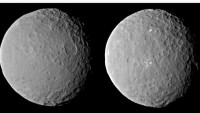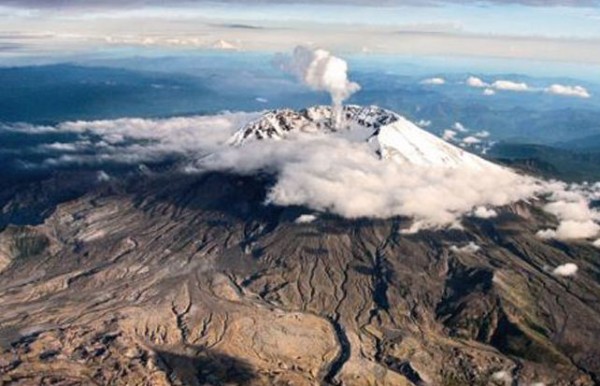Earthquake Swarm Rocks Mount St. Helens; No Need to Panic
| Arthur Dominic Villasanta | | May 07, 2016 06:27 AM EDT |
(Photo : USGS) Mount St. Helens
Over 130 small earthquakes have shaken Mount St. Helens over the past weeks, said the U.S. Geological Survey (USGS) that monitors this famous volcano in Washington State.
What makes this earthquake swarm worrisome is because the spectacular eruption of Mount St. Helens on May 18, 1980 that killed 57 persons was triggered by an earthquake.
Like Us on Facebook
USGS said the quakes had a strength ranging from magnitude 0.5 to 1.3 on the Richter Scale. Quakes with a magnitude of 2.5 or less are usually not felt by humans but can be recorded by a seismograph. Over 900,000 such quakes are recorded every year around the world.
It's the quakes with a magnitude of 7.0 to 7.9, which are considered major earthquakes, that do serious damage to buildings and manmade structures. There are about 20 of these annually.
The new Mount St. Helens' earthquake swarm occurred from 1.2 to four miles beneath the surface. Seismologists, however, are more worried about the frequency of this swarm and not their magnitudes. USGS recorded a similar swarm at Mount St. Helens in 2013, 2014 and in the 1990s.
The swarms have become more common since March 14, "reaching nearly 40 located earthquakes per week," reported USGS.
USGS, however, said "there is absolutely no sign that it will erupt anytime soon, but the data we collect tells us that the volcano is still very much alive." This conclusion is based on the absence of signs that precede an eruption.
Among these telltale signs are a large increase in the amount of magma; the release of anomalous gases; shallow quakes and deformation of the crust around the volcano.
Seismologists say the volcano is "recharging" or re-pressurizing the magma or semi-molten rock stored underneath it. USGS said this recharging can continue for years without an eruption occurring.
The 1980 eruption removed over 1,000 feet from the top of Mount St. Helens. It left a huge crater and spewed hot volcanic ash and dust across the Northwest USA.
TagsMount St. Helens, earthquake, earthquake swarm, U.S. Geological Survey, Washington State, eruption
©2015 Chinatopix All rights reserved. Do not reproduce without permission
 Ice volcanoes on Ceres Hint at Life Beneath its Icy Surface
Ice volcanoes on Ceres Hint at Life Beneath its Icy Surface See First Photos of the World's Newest Island in Tonga
See First Photos of the World's Newest Island in Tonga Muslim Terrorists Planned to Trigger Eruption of Yellowstone Supervolcano
Muslim Terrorists Planned to Trigger Eruption of Yellowstone Supervolcano Location and Probability of Yellowstone Super Eruption Predicted
Location and Probability of Yellowstone Super Eruption Predicted Mount Rainier Could Be On The Brink Of A Monstrous Eruption
Mount Rainier Could Be On The Brink Of A Monstrous Eruption
EDITOR'S PICKS
-

Did the Trump administration just announce plans for a trade war with ‘hostile’ China and Russia?
-

US Senate passes Taiwan travel bill slammed by China
-

As Yan Sihong’s family grieves, here are other Chinese students who went missing abroad. Some have never been found
-

Beijing blasts Western critics who ‘smear China’ with the term sharp power
-

China Envoy Seeks to Defuse Tensions With U.S. as a Trade War Brews
-

Singapore's Deputy PM Provides Bitcoin Vote of Confidence Amid China's Blanket Bans
-

China warns investors over risks in overseas virtual currency trading
-

Chinese government most trustworthy: survey
-

Kashima Antlers On Course For Back-To-Back Titles
MOST POPULAR
LATEST NEWS
Zhou Yongkang: China's Former Security Chief Sentenced to Life in Prison

China's former Chief of the Ministry of Public Security, Zhou Yongkang, has been given a life sentence after he was found guilty of abusing his office, bribery and deliberately ... Full Article
TRENDING STORY

China Pork Prices Expected to Stabilize As The Supplies Recover

Elephone P9000 Smartphone is now on Sale on Amazon India

There's a Big Chance Cliffhangers Won't Still Be Resolved When Grey's Anatomy Season 13 Returns

Supreme Court Ruled on Samsung vs Apple Dispute for Patent Infringement

Microsoft Surface Pro 5 Rumors and Release Date: What is the Latest?










